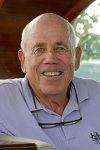Historical Vignette

Clyde Les Nash Jr., MD
(1932 - 2019)
Dr. Clyde L. Nash Jr., MD (“Les”) age 86, born November 25, 1932, passed away September 13, 2019. Les was the son of Katherine Seelbach Nash and Clyde Lester Nash. He grew up in Shaker Heights, Ohio where he attended Shaker Heights High, followed by Amherst College, two years in the US Army and Western Reserve Medical School. He was a retired Orthopaedic spine surgeon and Professor Emeriti of Case Western Reserve School of Medicine. He was considered by many to be a pioneer and surgeon-leader especially as it pertained to his involvement in the development of neuromonitoring in scoliosis and spinal deformity surgery. His medical career spanned over 30 years where he held leadership positions at University Hospitals, St Luke's, and MetroHealth Medical Center, all in the Cleveland, Ohio area. He is survived by his wife of 64 years, Deborah Hazzard Nash, and his three children (Elizabeth Patterson, Douglas Nash, and Katherine Quinn) and their spouses. His extracurricular life was full of many varied community activities both in Cleveland and in Boca Grande, Florida. This gentle, gifted, Renaissance man will be missed by his family, and all those who knew him or were in his care over these many years. It truly can be said, his was a " life well lived."
Dr. Nash was a gifted scoliosis surgeon and abundant tributes arrived after his passing from a lifetime of grateful patients and admirers alike. Not only were his surgical skills praised, but his character qualities were equally lauded. From his long-standing leadership within our Scoliosis Research Society (SRS), volunteerism at the Brittingham Library Board, to his reception of a child’s water balloon at a spine-team picnic, Dr. Nash was truly a “man for others.”
His seminal research in the techniques of intraoperative neuromonitoring have led to safer, more effective scoliosis and deformity surgery. Dr. Nash was an early leader in the development of these monitoring techniques. He and his colleagues, Dr. Jerald Brodkey, Dr Richard Brown, and Dr. Betty Grundy recognized the value of adapting the somatosensory evoked potentials (SSEPs) to help avoid catastrophic spinal cord injury during deformity surgery. This corresponded to the advent of spinal instrumentation and increased magnitudes of deformity correction. Soon a system was applied for the operating room, and SSEPs were used to guide early intervention in the event of an evolving neurological injury to improve outcomes. Beyond the development and validation of the coordinated approach between the anesthesiology team and the neuromontoring professionals, Dr. Nash educated the nation and the world on the benefits of SSEP monitoring. He left an incredible legacy and will be sorely missed.
Authors: Matthew J. Mermer, MD and David E. Morledge, PhD
Chair: George H. Thompson Committee: Andrew G. King; Acke Ohlin (E); Jeffrey P. Mullin (C); Jonathan N. Sembrano (C); Alexander A. Theologis (C); Patricia N. Kostial (A); Matthew J. Mermer; Behrooz A. Akbarnia (E); Richard M. Schwend; Jay Shapiro, Historian Elect



